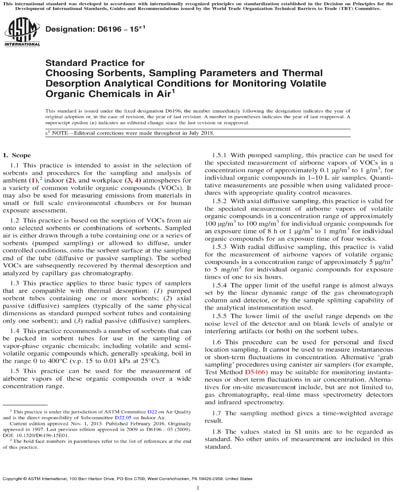Historical
ASTM D6196-15e1
Standard Practice for Choosing Sorbents, Sampling Parameters and Thermal Desorption Analytical Conditions for Monitoring Volatile Organic Chemicals in Air
1.1 This practice is intended to assist in the selection of sorbents and procedures for the sampling and analysis of ambient (1),2 indoor (2), and workplace (3, 4) atmospheres for a variety of common volatile organic compounds (VOCs). It may also be used for measuring emissions from materials in small or full scale environmental chambers or for human exposure assessment.
1.2 This practice is based on the sorption of VOCs from air onto selected sorbents or combinations of sorbents. Sampled air is either drawn through a tube containing one or a series of sorbents (pumped sampling) or allowed to diffuse, under controlled conditions, onto the sorbent surface at the sampling end of the tube (diffusive or passive sampling). The sorbed VOCs are subsequently recovered by thermal desorption and analyzed by capillary gas chromatography.
1.3 This practice applies to three basic types of samplers that are compatible with thermal desorption: (1) pumped sorbent tubes containing one or more sorbents; (2) axial passive (diffusive) samplers (typically of the same physical dimensions as standard pumped sorbent tubes and containing only one sorbent); and (3) radial passive (diffusive) samplers.
1.4 This practice recommends a number of sorbents that can be packed in sorbent tubes for use in the sampling of vapor-phase organic chemicals; including volatile and semi-volatile organic compounds which, generally speaking, boil in the range 0 to 400°C (v.p. 15 to 0.01 kPa at 25°C).
1.5 This practice can be used for the measurement of airborne vapors of these organic compounds over a wide concentration range.
1.5.1 With pumped sampling, this practice can be used for the speciated measurement of airborne vapors of VOCs in a concentration range of approximately 0.1 μg/m3 to 1 g/m3, for individual organic compounds in 1–10 L air samples. Quantitative measurements are possible when using validated procedures with appropriate quality control measures.
1.5.2 With axial diffusive sampling, this practice is valid for the speciated measurement of airborne vapors of volatile organic compounds in a concentration range of approximately 100 µg/m3 to 100 mg/m3 for individual organic compounds for an exposure time of 8 h or 1 µg/m3 to 1 mg/m3 for individual organic compounds for an exposure time of four weeks.
1.5.3 With radial diffusive sampling, this practice is valid for the measurement of airborne vapors of volatile organic compounds in a concentration range of approximately 5 µg/m3 to 5 mg/m3 for individual organic compounds for exposure times of one to six hours.
1.5.4 The upper limit of the useful range is almost always set by the linear dynamic range of the gas chromatograph column and detector, or by the sample splitting capability of the analytical instrumentation used.
1.5.5 The lower limit of the useful range depends on the noise level of the detector and on blank levels of analyte or interfering artifacts (or both) on the sorbent tubes.
1.6 This procedure can be used for personal and fixed location sampling. It cannot be used to measure instantaneous or short-term fluctuations in concentration. Alternative ‘grab sampling’ procedures using canister air samplers (for example, Test Method D5466) may be suitable for monitoring instantaneous or short term fluctuations in air concentration. Alternatives for on-site measurement include, but are not limited to, gas chromatography, real-time mass spectrometry detectors and infrared spectrometry.
1.7 The sampling method gives a time-weighted average result.
1.8 The values stated in SI units are to be regarded as standard. No other units of measurement are included in this standard.
1.9 This standard does not purport to address all of the safety concerns, if any, associated with its use. It is the responsibility of the user of this standard to establish appropriate safety, health, and environmental practices and determine the applicability of regulatory limitations prior to use.
1.10 This international standard was developed in accordance with internationally recognized principles on standardization established in the Decision on Principles for the Development of International Standards, Guides and Recommendations issued by the World Trade Organization Technical Barriers to Trade (TBT) Committee.
ASTM International [astm]

